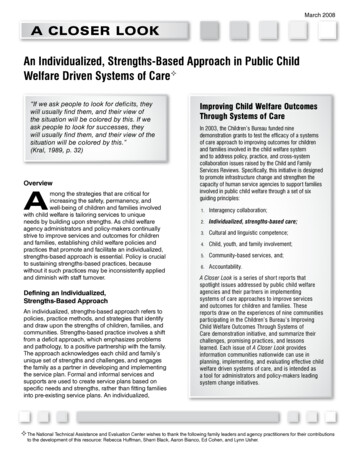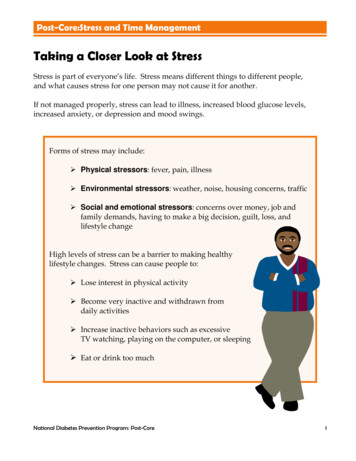
Transcription
March 2008A Closer lookAn Individualized, Strengths-Based Approach in Public ChildWelfare Driven Systems of Care “If we ask people to look for deficits, theywill usually find them, and their view ofthe situation will be colored by this. If weask people to look for successes, theywill usually find them, and their view of thesituation will be colored by this.”(Kral, 1989, p. 32)OverviewAmong the strategies that are critical forincreasing the safety, permanency, andwell-being of children and families involvedwith child welfare is tailoring services to uniqueneeds by building upon strengths. As child welfareagency administrators and policy-makers continuallystrive to improve services and outcomes for childrenand families, establishing child welfare policies andpractices that promote and facilitate an individualized,strengths-based approach is essential. Policy is crucialto sustaining strengths-based practices, becausewithout it such practices may be inconsistently appliedand diminish with staff turnover.Defining an Individualized,Strengths-Based ApproachAn individualized, strengths-based approach refers topolicies, practice methods, and strategies that identifyand draw upon the strengths of children, families, andcommunities. Strengths-based practice involves a shiftfrom a deficit approach, which emphasizes problemsand pathology, to a positive partnership with the family.The approach acknowledges each child and family’sunique set of strengths and challenges, and engagesthe family as a partner in developing and implementingthe service plan. Formal and informal services andsupports are used to create service plans based onspecific needs and strengths, rather than fitting familiesinto pre-existing service plans. An individualized,Improving Child Welfare OutcomesThrough Systems of CareIn 2003, the Children’s Bureau funded ninedemonstration grants to test the efficacy of a systemsof care approach to improving outcomes for childrenand families involved in the child welfare systemand to address policy, practice, and cross-systemcollaboration issues raised by the Child and FamilyServices Reviews. Specifically, this initiative is designedto promote infrastructure change and strengthen thecapacity of human service agencies to support familiesinvolved in public child welfare through a set of sixguiding principles:1.Interagency collaboration;2.Individualized, strengths-based care;3.Cultural and linguistic competence;4.Child, youth, and family involvement;5.Community-based services, and;6.Accountability.A Closer Look is a series of short reports thatspotlight issues addressed by public child welfareagencies and their partners in implementingsystems of care approaches to improve servicesand outcomes for children and families. Thesereports draw on the experiences of nine communitiesparticipating in the Children’s Bureau’s ImprovingChild Welfare Outcomes Through Systems ofCare demonstration initiative, and summarize theirchallenges, promising practices, and lessonslearned. Each issue of A Closer Look providesinformation communities nationwide can use inplanning, implementing, and evaluating effective childwelfare driven systems of care, and is intended asa tool for administrators and policy-makers leadingsystem change initiatives.²The National Technical Assistance and Evaluation Center wishes to thank the following family leaders and agency practitioners for their contributionsto the development of this resource: Rebecca Huffman, Sharri Black, Aaron Bianco, Ed Cohen, and Lynn Usher.
strengths-based assessment focuses on the complexinterplay of risks and strengths among individualfamily members, the family as a unit, and the broaderneighborhood and environment. The individualized,strengths-based approach is an overall philosophical viewsupported by policies and standards that encompasses arange of concrete practices of child welfare caseworkersand other service providers at various points from thetime the child and family enter the system to when theyleave (see Figure 1).Historically, child welfare systems (and other humanservices) emphasized efficient provision of services withlittle attention to family systems and approached clientsfrom a deficit model. Traditional practices, focusing onwhat was wrong with the child or the family, resulted in achild welfare system that was punitive and stigmatizingin its approach and often produced passive and resistantresponses from clients (Waldfogel, 2000). Beginning in theearly 1980s, strengths-based case management was firstimplemented in community mental health centers (Brun& Rapp, 2001) and since then has been implemented inmany other health and social service settings.A review of the literature suggests at least three pathwaysby which strengths-based practices benefit clients:1) by influencing the extent of clients’ engagement inprogram services; 2) by increasing family efficacy andempowerment; and 3) by enhancing families’ relationship-Figure 1. Individualized,strengths-Based Approachand Practicesbuilding capacity and social support networks (Green,McAllister, & Tarte, 2004).Although there is limited research on the effects of anindividualized, strengths-based approach on child andfamily outcomes for the population of child welfareclients, prior studies of other service recipients (e.g.,early intervention, mental health, elderly services) havefound that a family-centered, strengths-based approachis associated with increased service engagement (Greenet al., 2004; Shireman, 1998), increased parentingcompetency (Green et al., 2004; Whitley, 1999), andenhanced interaction among family members (Green et al.,2004; Huebner, Jones, Miller, Custer, & Critchfield, 2006).Individualized, Strengths-Based Approaches ina Child Welfare Driven System of CareAn individualized, strengths-based approach to workingwith families embodies important principles of childwelfare practice promoted by the Children’s BureauChild and Family Services Review process. The Childand Family Services Reviews were designed to supportkey practice principles, including tailoring interventionsto meet the specific needs of children and families;offering children and families opportunities to provideinput into the identification of their strengths, needs, andgoals; and promoting parents’ strengths by emphasizingpartnership with service providers. These principles aredesigned to support improved outcomes for childrenand families.The Child and Family Services Review process alsofocuses on two other systems of care principlesthat are closely related to individualized, strengthsbased approaches:family involvement andcultural competency. AnINDIVIDUALIZED,individualized, strengthsSTRENGTHS-BASED APPROACHbased approach dependson collaboration betweenthe service provider andclient, in which individualsand families are viewed asequal partners in the changePRACTICESprocess. (See also A CloserDocumentationLook: Family Involvement inInvestigationsin case recordsPublic Child Welfare DrivenService provisionSystems of Care at www.and referralsAssessmentsStaff m).Policy developmentOngoing case managementCultural competency is aA Closer look An Individualized, Strengths-Based Approach in Public Child Welfare Driven Systems of Care2
prerequisite for implementing an individualized, strengthsbased approach because individuals from differentcultural backgrounds may hold different values and makedifferent judgments about how strengths are definedand the types of interactions that communicate respect.Issues of culture, gender, age, religious background, andclass are addressed in individualized, strengths-basedcase plans.Challenges and Strategies in Following anIndividualized, Strengths-Based ApproachThe experiences of the nine grant communities involvedin the Improving Child Welfare Outcomes ThroughSystems of Care initiative provide useful information“[Individualized, strengths-based practice] was anotherthing that we had to get used to. But we’ve come a longway. Everything from doing risk assessments to our planswith the families. We really try to focus on and try to pullany little strength out that we can and work on it.”Kms of CareE R LO ODriven SysteA C LO SWelfareldhiily ofCfamirlicthehubin P will remain or return to live witlvemenlect tedchildrenFamily Invo2005.)or negt of abusedman Ser vices,Outcomes cenHuAlmost 80 per par tment of Health andDeorigin. (U.S.nes:Look examiserCloAofThis issuet;involvemenay;ns of family Definitioday and todlfare, yesterweildchinnges in Familiesnd to challeities respount;mmencoinvolvem Granting familystrengthenent in systemily involvemnalizing fam Operatio dcychange; anfamily-agenrtpoto supation.ders can do What lea s for system transformpartnershipwOverviepercentagech a largeecause suh childinvolved witofof childrentheir familyhwitidealwelfare ress is essentiiliefamnt withemeThges.gaorigin, enl outcomesfustemessyccinsuntgfor achievin consumer engagemee oftablished inimportancen well ess,besinghannntJe;lip, 2002improveme05;(e.g., Chrisymous, 20the literaturerents Anonwelfarer, 2003; PaState child2002; Milnedi, 2006). AsanskslencieZaenWhipple &hin their agtors work wit vate stakeholders toadministravementc and priblipropuImermwith othnt Prograly Servicesd implemeild and Famidevelop anponse to Ch and participationPlans in resinclusionmes andilytcofamou,gReviewsimprovinbe vital forpromise toge.stem chansyingterfose andbe effectivchange toa cohesiveFor systemguided by). The, it must besustainable mework (Milner, 2003 foundational stemsagencystrategy.ild welfareon which ch mprehensive changenciples ofcopriasixildbuthencat, one ofenaddressesemre,olvms of caFamily invstesynvefurtherre drisigned tochild welfartnership de goals by:pagicatema strcy and systeoverall agenBreChild WelfaImprovingrestems of CaThrough Sydemonstrationfunded nineeauchChildren’s Bur systems of care approaIn 2003, theedy of at the efficacfamilies involv e,grants to teschildren andpracticoutcomes forress policy,addtoldto improvinganded by the Chilfare systemraisweldueschiisstionin theve istem collaboraly, this initiatiand cross-sys es Reviews. Specificalngthenstreandvicngeand Family Serastructure chato suppor tpromote infrdesigned tovice agenciesof sixof human ser ld welfare through a setthe capacityin public chiedolvinvfamilies:lescipguiding printion;ency collabora1. Interage;hs-based carualized strengt2. Individe;tic competencl and linguis3. Culturaement;family involvyouth, and4. Child,es, t spotlightshort reportstnersand their park is a series ofA Closer Loofare agenciespublic child wel approaches to improveeaddressed bysystems of car n and families. These reportsingentlemin impinchildrepar ticipatingoutcomes forcommunitiesservices andeseriences of ninelfare Outcomdraw on the exp eau’s Improving Child WeBurinitiative, andiontratonsthe Children’sonsdemtems of Carectices, and lessThrough Syspromising pra informationir challenges,ssummarize the e of A Closer Look provideing,entlemimp,issulearned. Eachuse in planninge,nationwide can fare driven systems of carcommunitieswelcy-makerseffective childtrators and poliand evaluatingtool for adminisaasdndees.and is intechange initiativleading systemning their owin developas partnerssiliefamg Engaginopingcase plans;ilies in develng with famg and worki Recruitin rt services;ngcision-makideinpeer suppotents tos to participavice recipiering familie Empowe their experience as serand applyties.ange activisystem ch6.rs for theirpractitioneand agency Sharri Black, Familyily leaderscy, Martinez,rtinez, CA;following fam4Permanennency, Mathank ther, Partneringring4Permawishes toatotneterrdinParr,Cenr CootionPartne, PAent Partneand Evaluarett, Parenti Knittel, Par and Youth, HarrisburgAssistanceCheryl Barneka, KS; Judal Technical ent of this resource:ldreTopione,ChiNatCarnty, Theelopmtems ofphin Couns to the dev Family Centered Sys ch Coordinator, Daur,contributiotreaCoordinatoof Care OuInvolvement, Systemsen SpenceCA; and Hel—Child Welfare Supervisorto administrators and stakeholders nationwide forimplementing an individualized, strengths-basedapproach.1. Agency Culture and Characteristics of FamiliesInvolved with Child Protective ServicesChallenges. Grant communities reported that it oftenis challenging for agencies to move from a pathologybased model to an individualized, strengths-basedapproach given the potentially severe threats to children’ssafety and risk factors, such as physical or sexualabuse or addiction, that are present in some families.An additional complicating factor is that the majority offamilies involved with child protective services do not seekservices voluntarily and often are viewed as resistant ornon-compliant, which interferes with the establishment of aworking alliance between the caseworker and the family.Strategies. Despite these challenges, supervisorsinterviewed in several grant communities reported thatthere is a greater focus now (compared to past years)on identifying strengths in families. They also reported agreater emphasis on identifying non-traditional servicesand supports for families.Strategies used by grant communities to overcomechallenges related to agency culture and characteristicsof families involved with child protective services include:A Closer look An Individualized, Strengths-Based Approach in Public Child Welfare Driven Systems of Care3
T raining—All grant communities provide training onstrengths-based approaches and cultural competencyto staff from all child-serving agencies, with emphasison practical application. Training formats rangefrom traditional conferences to more informal casediscussions. For example, New York discusses casescenarios at monthly network meetings as part ofsystems of care development.1 North Dakota providesparent coordinator training entitled “We Are AllRelated,” which emphasizes the strengths of the familyand the culture. Collaboration with Other Agencies—Most grantcommunities are using collaboration and networkingwith other agencies and faith-based organizations tosupport strengths-based approaches. For example,Colorado provided material for sermons to begiven by clergy at area churches on communityacknowledgment of and response to child welfareissues. Collaboration is key to influencing existingand potential partners to adopt an individualized andstrengths-based approach with children and families,and can foster creative identification and expansionof informal supports to help families. Networking alsohelps to engage partners in a system approach andabandon the categorical model in which services aredelivered in isolation. National Technical Assistance andEvaluation Center for Systems of CareCollaborative Member Survey FindingsCurrently, the extent to which systems of care collaborativemembers agree that systems of care activities have beeneffective in increasing individualized, strengths-basedapproaches is mixed, with differences evident among grantcommunities. On a scale of 1 to 5, where higher is strongeragreement, the average scores of collaborative membersacross all nine grant communities ranged from 3.3 (neutral)to 4.4 (agree) and the median across grant communitieswas 3.8. Collaborative members will be surveyed againtoward the end of the initiative to determine if perceptionschange over time.—Systems of Care Collaborative Survey Data,Fall/Winter 2006/20071.Improving Child Welfare Outcomes Through Systems of Caregrantees are indicated by State name. Demonstration site namesare listed on page 7.Assessment Tool—Several grant communities(California, Colorado, Kansas, North Carolina,and Oregon) have implemented strengths-basedassessments of children and families involved withchild welfare to identify needs and match services tothose needs. For example, the Colorado Division ofChildren, Youth, and Families’ assessment tool, FamilySocial History and Assessment Summary, specificallyasks for a description of the family’s strengths. Using astructured intake tool, the North Carolina Departmentof Social Services begins the process of gatheringinformation about family strengths at the first contactwith the reporter by including questions about whatthe family does well.2. Child Welfare Staff TurnoverChallenges. Child welfare staff turnover is identifiedfrequently by child welfare supervisors and grantee projectdirectors as one of the greatest obstacles to implementingand sustaining an individualized, strengths-basedapproach. The child welfare field often is characterizedby high staff turnover, which can lead to low staff morale,excessive workloads for those who remain, and mostimportantly, feelings of rejection and insignificance by thechild or family. A particular challenge for strengths-basedA Closer look An Individualized, Strengths-Based Approach in Public Child Welfare Driven Systems of Care4
care cited by grantees is orienting new staff to the systemsof care philosophy, values, and practices, which can betime consuming and frustrating when it must be donerepeatedly as new staff members are hired.Strategies. Strategies to promote an individualized,strengths-based approach amidst high rates of turnoverinclude ongoing training, not only for caseworkers,but also for supervisory staff, policy- and decisionmakers, and community partners. Comprehensivetraining is viewed as an important factor in fosteringshared responsibility for child welfare as well as sharedcommitment to managing, supervising, and workingwith peers from a strengths-based approach. Sharedresponsibility can alleviate the sense of isolation andbeing overwhelmed among caseworkers which in turncan contribute to less staff turnover. Training for Child Welfare Supervisors—At the Statelevel, the North Carolina Department of Social Serviceshas developed several trainings for child welfaresupervisors to allow for exploration and identificationof their own strengths and to encourage strengthsbased supervision of caseworkers. Strengths-basedsupervision can contribute to a more positive workenvironment that is characterized by decreased staffturnover and increased job satisfaction. North Carolina and Nevada offer ongoing trainingon family-centered child and family team meetingsand facilitation skills for all child welfare staff. Also, toencourage agencies to practice for and participate inchild and family teams, North Carolina developed acollaborative child and family team curriculum that isused to train staff across agencies. Studies show thatchild welfare staff have an increased commitment totheir work when they participate in training that leadsto greater competencies (Zlotnik, DePanfilis, Daining,& Lane, 2005).3. Time ConstraintsChallenges. Among the biggest challenges faced bychild welfare staff is the issue of time constraints, duein large part to sizeable caseloads, which limit the timecaseworkers can spend with families. The lack of time hasseveral effects that conflict with the principle of strengthsbased, individualized care. It often prevents child andfamily team meetings from being scheduled as frequentlyas may be necessary. Also, limited time can require teammeetings to be held in the child welfare office, rather thanin a community setting, because there is not enough timefor caseworkers to effectively plan for or travel to a familyfriendly location. As a consequence, family membersand their informal supports are less likely to participate.The child welfare office setting can emphasize the powerdifferential between the caseworker and the family.Additionally, the less time caseworkers and supervisorshave, the more likely it is for children and families in thechild welfare system to have “cookie cutter” case plansthat are not individually tailored.Strategies. Several grant communities (California,Colorado, Kansas, North Carolina, and Oregon) relyon policies, mandates, and protocols that have beendeveloped to help ensure that child and family teammeetings take place as intended. By having a formalizedstructure that requires child and family participation andinput, child welfare workers are more apt to prioritizechild and family meetings among competing demandson their time. Policies mandating child and family inputensure the child and family guide development of thecase plan; otherwise, the process ultimately can bemore costly in terms of staff time and resources. TheKansas child welfare agency has mandated time frameswithin which family meetings must take place and differdepending on the stage of the case. Systems of careproject leaders reported that it is useful for collaborativemembers and child welfare staff to share success storiesto help caseworkers and supervisors understand howand why taking extra time to use an individualized,strengths-based approach with families is worthwhile.Grant communities reported that this internal marketingto achieve staff buy-in is facilitated by discussion ofindividual cases at staff meetings and highlighting howa strengths-based approach has contributed to betterservice outcomes. When child welfare workers hearabout successful cases, the probability is greater thatindividualized, strengths-based practice will becomeinstitutionalized as a permanent part of the child welfareinfrastructure.A Closer look An Individualized, Strengths-Based Approach in Public Child Welfare Driven Systems of Care5
4. Lack of Services and Access to ServicesChallenges. Many of the grant communities, particularlythe rural ones, reported that a lack of services poses amajor challenge to creating individualized service plans.For example, if there is only one parenting class offeredin the area, the parent of an infant and the parent of anadolescent do not receive parenting education tailored totheir individual needs. Also, if fewer services are available,families frequently are forced to wait longer for neededservices. Lack of transportation is also a challenge toaccessing services.Strategies. To help child welfare workers learn moreabout existing services and develop non-traditional andcommunity (natural) supports, some grantee communitieshave created child welfare positions specifically to identifycommunity services, develop collaborative relationships,and educate other child welfare staff about resources. The Oregon Department of Human Services employs aresource developer, and one county in North Carolinadeveloped a community social worker position. One North Carolina community also engages “familypartner” organizations. These local community-basedorganizations help recruit parent and youth volunteersand mentors for child welfare child and family teams,provide facilities for child and family team meetingsto be held in the community rather than at the childwelfare office, and identify and recruit informal andnon-traditional supports for families. P ennsylvania established an extensive networkof natural supports to which caseworkers canhelp families connect. A system of care outreachcoordinator worked with faith-based organizationsand created a faith-based subcommittee that involvesa wide variety of religious denominations andorganizations. This subcommittee has been successfulin implementing several activities, such as starting asummer camp program. New York holds ongoing meetings of child protectiveservices supervisors, staff, and community-basedservice providers so the child and family will haveaccess to a broad array of individualized services.During service planning meetings, caseworkers areprovided with resource referrals that address specificneeds of children and families.Implications for Administratorsand Stakeholders“When you go in to work with a family, you have to get toknow the family and get an idea of what their strengthsare. But also when you’re working within the family groupconference, you’re looking for strengths. Your initial [task]is to talk about what the strengths are with the family. Andhaving been in those conferences, it’s been exciting to seecaseworkers identify the families’ strengths.”—Child Welfare SupervisorAn individualized, strengths-based approach to workingwith families involved in child welfare is critical to creatinga responsive child welfare driven system of care that willhelp ensure children’s safety, permanency, and well-being.Child welfare administrators and policy-makers have theopportunity to enhance individualized, strengths-basedapproaches to families involved with child welfare as part ofProgram Improvement Plans that stem from the Child andFamily Services Reviews. Senior administrators, programmanagers, and policy-makers can help child welfareagencies minimize or overcome potential challenges byimplementing certain policies and practices.Based on the experiences of the communities involvedin the Improving Child Welfare Outcomes ThroughSystems of Care demonstration initiative, promisingpractices include:A Closer look An Individualized, Strengths-Based Approach in Public Child Welfare Driven Systems of Care6
Consistent and ongoing training for child welfare staffand partner agency staff to change traditional childwelfare agency culture and philosophy and to provideconcrete skills and strategies for identifying child andfamily strengths and unique needs.Management and supervisory staff focus on workers’strengths, addressing unique career developmentneeds, and rewarding staff for demonstrating anindividualized strengths-based approach with clients(e.g., sharing success stories at staff meetings).Revision of assessment tools to focus specifically onidentification of child and family strengths.Interagency collaboration, on individual cases as wellas on a community level, to increase availability andfamily and service provider awareness of informal andcommunity supports. Designation of one child welfarestaff member as a community liaison or outreachcoordinator can be instrumental for partnering withfaith-based and other community organizations.Discrete activities, such as training sessions, should notbe confused with implementation of a comprehensivesystem of care. Thorough and ongoing evaluation ofthe systems of care infrastructure and services, systempartners, and practices of caseworkers, supervisors,and administration can be helpful in monitoring whetheractivities are leading to intended and meaningfuloutcomes for families.The activities of the nine grant communities in theImproving Child Welfare Outcomes Through Systemsof Care demonstration initiative are laying an importantfoundation for the child welfare field’s efforts to partnerwith children and families, with their unique strengthsdriving the help they receive. The work of the grantcommunities can have a significant impact as othercommunities nationwide change the way child welfareservices are delivered.Improving Child Welfare OutcomesThrough Systems of Care DemonstrationGrant CommunitiesCalifornia – Partnering4Permanency – Valerie Earley,Project Director, vearley@ehsd.cccounty.usColorado – Jefferson County System of Care – SusanFranklin, Project Director, SFrankli@jeffco.usKansas – Family Centered Systems of Care – Beth Evans,Project Director, ebme@srs.ks.govNevada – Caring Communities Project – Tiffany Hesser,Project Director, HesserTi@co.clark.nv.usNew York – The CRADLE in Bedford Stuyvesant: ASystems of Care Initiative – Nigel Nathaniel, ProjectDirector, Nigel.Nathaniel@dfa.state.ny.usNorth Carolina - Improving Child Welfare OutcomesThrough Systems of Care – Eric Zechman, ProjectDirector, ericzechman@ncmail.netNorth Dakota – Medicine Moon Initiative: Improving TribalChild Welfare Outcomes Through Systems of Care – DebPainte, Project Director, debp@nativeinstitute.orgOregon – Improving Permanency Outcomes Project –Patrick Melius, Project Director,Patrick.J.Melius@state.or.usPennsylvania – Locally Organized Systems of Care –Andrea Richardson, Project Director,c-arichard@state.pa.usThe National Technical Assistance and EvaluationCenter for Systems of Care is funded by theChildren’s Bureau, under contract with ICFInternational. The Center assists and supportsgrantees funded through the Improving ChildWelfare Outcomes Through Systems of Caredemonstration initiative by providing training andtechnical assistance and a national evaluation ofthe demonstration initiative. Contact: RaymondCrowel, Project Director, 10530 Rosehaven Street,Suite 400, Fairfax, VA 22030-2840, 703.385.3200.A Closer look An Individualized, Strengths-Based Approach in Public Child Welfare Driven Systems of Care7
ReferencesAdditional ResourcesBrun, C., & Rapp, R. (2001). Strengths-based casemanagement: Individuals’ perspectives on strengths andthe case manager relationship. Social Work, 46(3), 1–11.Using the Behavioral and Emotional Rating ScaleGreen, B. L., McAllister, C. I., & Tarte, J. M. (2004). Thestrengths-based practices inventory: A tool for measuringstrengths-based service delivery in early childhood andfamily support programs. Families in Society, 85(3),327–334.Huebner, R. A., Jones, B. L., Miller, V. P., Custer, M., &Critchfield, B. (2006). Comprehensive family services andcustomer satisfaction outcomes. Child Welfare, tonline/strength/empower/3.aspChild Welfare Information Gateway, Systems of CareResource /library.cfmNorth Carolina Family Assessment Scale, Version 2.0,Definitions and User’s Guidehttp://ssw.unc.edu/jif/publications/Kral, R. (1989). Strategies that work: Techniques forsolutions in the schools. Milwaukee, WI: Brieg FamilyTherapy Center.Shireman, J. (1998). System of care evaluation: Theevaluation of strengths/needs based practice. [Electronicversion]. Portland, OR: Portland State University, RegionalResearch Institute.Waldfogel, J. (2000). Reforming child protective services.Child Welfare, 79(1), 43–57.Whitley, D. (1999). Strengths-based case management:The application to grandparents raising grandc
and potential partners to adopt an individualized and strengths-based approach with children and families, and can foster creative identification and expansion of informal supports to help families. Networking also helps to engage partners in a system approach and abandon the categorical model in which services are delivered in isolation.










